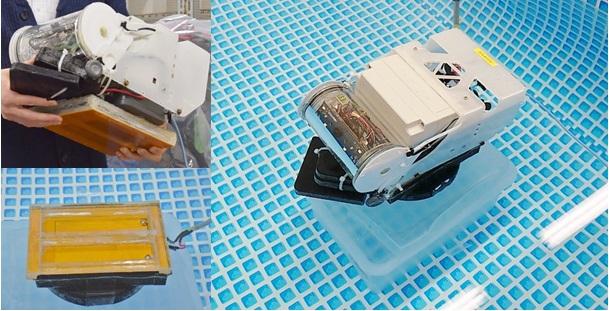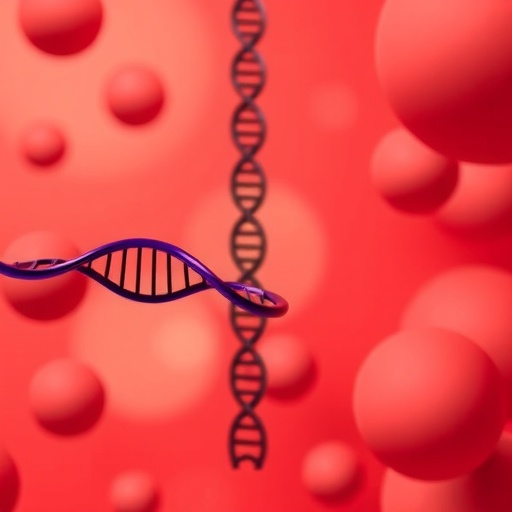For drones that can be stationed underwater for the adoption of ICT in mariculture

Credit: COPYRIGHT (C) TOYOHASHI UNIVERSITY OF TECHNOLOGY. ALL RIGHTS RESERVED.
Overview:
Associate professor Masaya Tamura, Kousuke Murai (who has completed the first term of his master’s program), and their research team from the Department of Electrical and Electronic Information Engineering at Toyohashi University of Technology have successfully transferred power and data wirelessly through seawater by using a power transmitter/receiver with four layers of ultra-thin, flat electrodes. In the field of wireless power transfers, seawater behaves as a dielectric with extremely high loss, and achievement through capacitive coupling is difficult. Up until now, it had been thought that wireless power transfers could only be achieved through magnetic coupling. This time, with a focus on the high-frequency properties of seawater, a third method for conductive coupling was devised, and a power transmitter/receiver was developed to achieve highly-efficient power transfers.
Details:
The number of people involved in the Japanese fishing industry continues to decrease yearly as the average age increases. One reason for this is the large amount of high-intensity manual labor which has to rely on human hands. To improve this situation, automation is advancing through the use of robots that clean aquaculture nets, etc. In the future, it is expected that robots (underwater drones) will be developed that are stationed in seawater so that water quality and environmental management, checks on fish growth, etc., can all be managed robotically. However, because these drones are battery-powered, it is necessary to pull them out of the water, charge them, and have them dive back into the water repeatedly. Additionally, the data collected underwater must be collected at this time. The key to this problem is the development of technology to wirelessly transfer power and data in seawater through a power supply station. In particular, as these drones are lightweight, and because increasing the weight and volume makes controlling buoyancy and orientation difficult, technology that is lightweight and space-conserving must be realized. Associate professor Masaya Tamura and his team of researchers have developed a new type of electric transmitter/receiver that achieves highly-efficient wireless power transfers even in seawater.
The efficiency of the wireless power transfer depends on the kQ product, which is the product of the coupling coefficient k between the power transmitter and receiver and the Q-factor of the power transmitter/receiver loss including the influence of the surrounding environment. Efficiency improves as k approaches 1 and the Q-factor increases. However, high-frequency electric current flows in highly conductive dielectrics like seawater, making it difficult to discuss k and the Q-factor in isolation. However, because the principle whereby efficiency improves as the kQ product increases does not change, key parameters were identified for improving efficiency from an equivalent circuit that focused on the conductivity of seawater from the viewpoint of the kQ product. A design theory was then established wherein the kQ product indicated the maximum value, and the power transmitter/receiver was designed. Based on this, an RF-RF power transfer efficiency of 94.5% at a transfer distance of 2 cm and of at least 85% at a transfer distance of 15 cm was achieved across a wide band. A power transfer efficiency of at least 90% can even be maintained at a transfer distance of 2 cm with 1 kW of electric power. Moreover, high-speed transfers can be achieved to maintain high efficiency across a wide band. The team was successful in using the electric transmitter/receiver that they developed to charge a capacitor and to use this power to drive a camera module that transferred video in real-time through the same electrical transmitter/receiver. The transfer speed this time was about 90 Mbps, but higher speeds are possible. Experiments to transfer power and data to a small underwater drone, with the expectation that the drone would park on the power supply station, were also successful. The total weight of the electrical receiver and electrical power circuit mounted on the drone at this time was very light at around 270 g.
Development Background:
The leader of the research team, associate professor Masaya Tamura, stated: “In ion-rich seawater, it was expected that high-frequency electric current would flow with minimal loss. When researching wireless power transfers in freshwater, and when analyzing the way power transfer efficiency changed with the salinity of the water, we encountered a phenomenon where efficiency would decrease by a few percent as the salinity increased, but from a certain salinity, the efficiency would recover and be maintained at about 20%. I firmly believed that this was evidence substantiating my prediction, and we developed an operational theory from an equivalent circuit for a power transmitter/receiver to investigate and clarify these results in detail. We then designed the structure of the power transmitter/receiver based on that theory, and after creating the prototype and performing the measurements, we obtained results for a power transfer in seawater with an efficiency of at least 90%. To prevent chemical changes to the surface of the electrodes that occur in seawater when large amounts of power are supplied, an insulated coating was applied. We were surprised to achieve efficiency of at least 90% even under these conditions.”
Future Outlook:
The research team believes that these research results will allow drones to transfer data and be recharged in seawater without significant design changes to underwater drones, and that they will contribute to rapid improvements in operational efficiency. The power transmitter/receiver that was developed is very simple and lightweight, meaning that the increase in weight for underwater drones can be minimized. Their ultimate goal is to contribute to the development of underwater drone systems that can be entirely managed on land. The results of this research are planned to be announced in the future in publication, at academic conferences, etc.
###
Reference:
Masaya Tamura, Kousuke Murai, Marimo Matsumoto, “Design of Conductive Coupler for Underwater Wireless Power and Data Transfer,” IEEE Transaction on Microwave Theory and Techniques, vol. 69, no. 1, pp.1161-1175, Jan. 2021, doi: 10.1109/TMTT.2020.3041245. (Early Access)
This work was supported in part by the Japan Society for the Promotion of Science (JSPS) Grants-in-Aid for Scientific Research (KAKENHI) JP18K04262.
Media Contact
Yuko Ito
[email protected]
Related Journal Article
http://dx.




